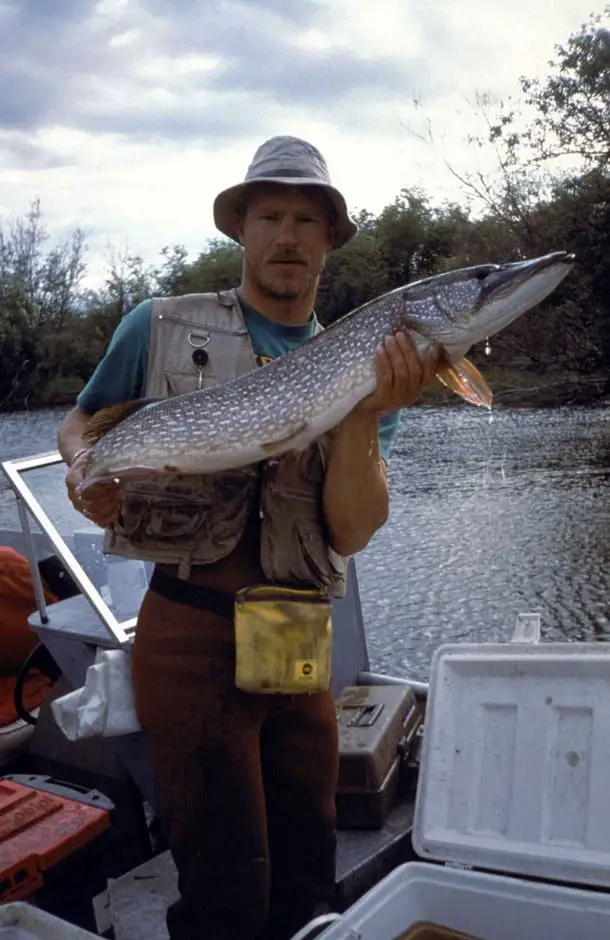If you are an angler and fish lakes and rivers where northern pike proliferate, then you most likely already know how incredibly aggressive they are and how wiley they can be when you are trying to handle one.
In the regions where they are common, pike are most likely responsible for more hooking accidents and hospital trips than any other species, and I can personally account for that, I can remember one incident where both me and my fishing buddy both had trebles lodged into our thumbs and played tug of war trying to get them out as kids, within an hour of fishing.
If you want to avoid someone using pliers and pulling at a hook lodged into your body, or a hospital trip, stick around. Here are some tips on how to unhook pike safety to reduce or avoid these negative outcomes.
Release Tools
One of the easiest ways to ensure the safe un-hooking of a pike is to ensure you have the proper tools while out fishing.
Every angler should have these tools regardless of species and include items in the boat or tackle box such as:
- A pair of longnose or needle-nose pliers (we recommend these)
- Hook cutter
- Hook removal tool like the “grab-it” hook remover
- Net (see our Recommended Gear Page)
- Boga grips
- Pair of jaw spreaders
Without these tools, the risk of you getting injured and hooked goes through the roof. Imagine trying to unhook a treble hook from a thrashing pike’s mouth with your bare hands. The chances of you getting hooked are very high. Especially with treble hooks.
In general with single hooks or lures like bass jigs, the risks are pretty minimal although they still exist.
As any experienced crankbait anglers can tell you from first-hand experience: treble hooks are the real culprits here.
Netting Pike Safely
Netting pike is a love/hate relationship for me personally, and the reason for this can really be broken down by hook and lure type.
Single hook lures are not typically a problem when it comes to netting pike, but if you are like me, who fishes for pike in the mid 30 to 40-inch class or larger, you are typically running musky lures, which have anywhere from 2 to 3 treble hooks, this is where difficulties with netting start.
Northern Pike does not respond well to nets and will thrash and “gator roll” while inside it, getting those treble hooks tangled severely to the point that the pike looks like a mummy, all wrapped and twisted up in the net.
This more than likely is going to take considerable time to untangle as well as unhook the fish, and the process will put your hands in harm’s way for a considerable amount of time, not to mention being detrimental to the fish.
Muskies Are Much Easier to Net
Muskies, on the other hand, are much more docile when netted, and this becomes much less of an issue. In many cases, especially if the musky has been caught and released multiple times, the fish will simply sit in the net while in the water calmly and wait for you to do your unhooking business and release it.
At that point the muskie is likely to slowly swim away with some hurt pride, while their cousin the pike, will make your life a hell more often than not when placed in a net.
For this reason, I would avoid the use of a net if at all possible, but always have one with you in the event you have no choice.
Boga Grips and Jaw Spreaders
Many serious pike and musky anglers do not use or like Boga grips, and the main reason is people don’t know how to properly use them and mishandle the fish, which can be very damaging to their bodies and severely hurt their chances for survival.
Over 90% of musky anglers are strictly catch-and-release practitioners today, which is an amazing statistic and boils down to caring about healthy populations and the realization of how low population densities for the species is.
Pike are far more common, and many anglers choose to harvest them. If this is the case, then the Boga grip and jaw spreader issue don’t really apply here.
If you intend to release your caught fish, be sure you have jaw spreaders with blunted ends or safe ends that won’t puncture through the floor and roof of their mouths. Many jaw spreaders on the market today even feature rubber or plastic on the ends for increased fish protection.
For Boga grips and a successful release, you want to ensure you hold the fish using the Boga Grip while leaving the fish in the water, and if you do remove them from the water, it’s critical that you do not hold the fish vertically as this can really mess up their internal organs and spine.
Instead you should hold them horizontally while supporting their body with your opposite hand.
Take Pike off the Hook Safely by Using the Right Tools
When you un-hook a northern pike, you should always proceed with caution and keep your hands as far away from the hooks as possible. Using the right tools, you can deal with pike confidently and do so much safer than by using your bare hands.
Once you have experience handling these hyperactive fish, you will become proficient at doing so, and it will be a walk in the park.
And always have a first aid kit ready, just in case. Because even when taking the proper precautions, sometimes that wildly shaking pike is going to end up getting you.
Check here for an official guide on how to safely remove a fishhook from the skin.
Other Pike Fishing Articles You May Enjoy

